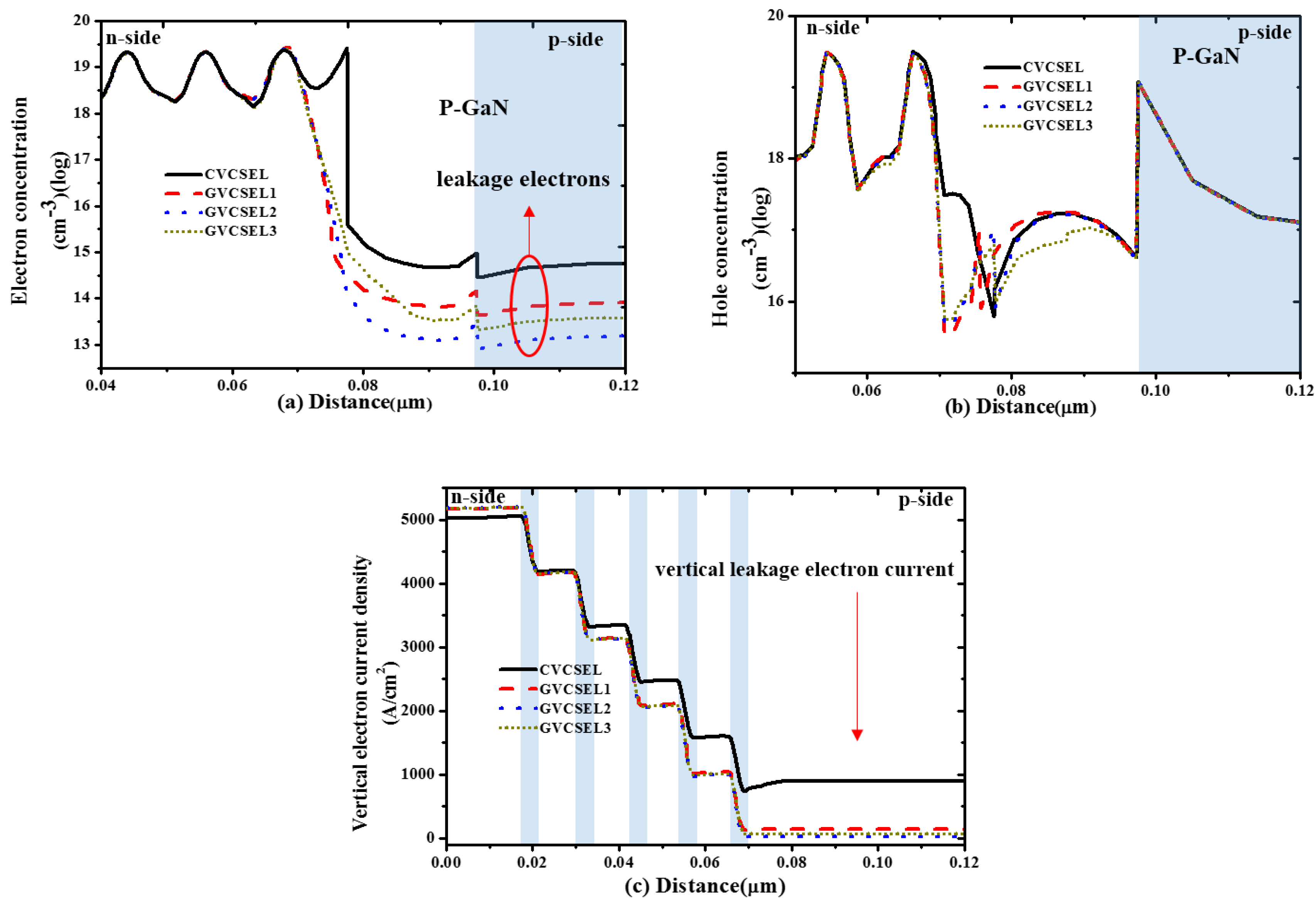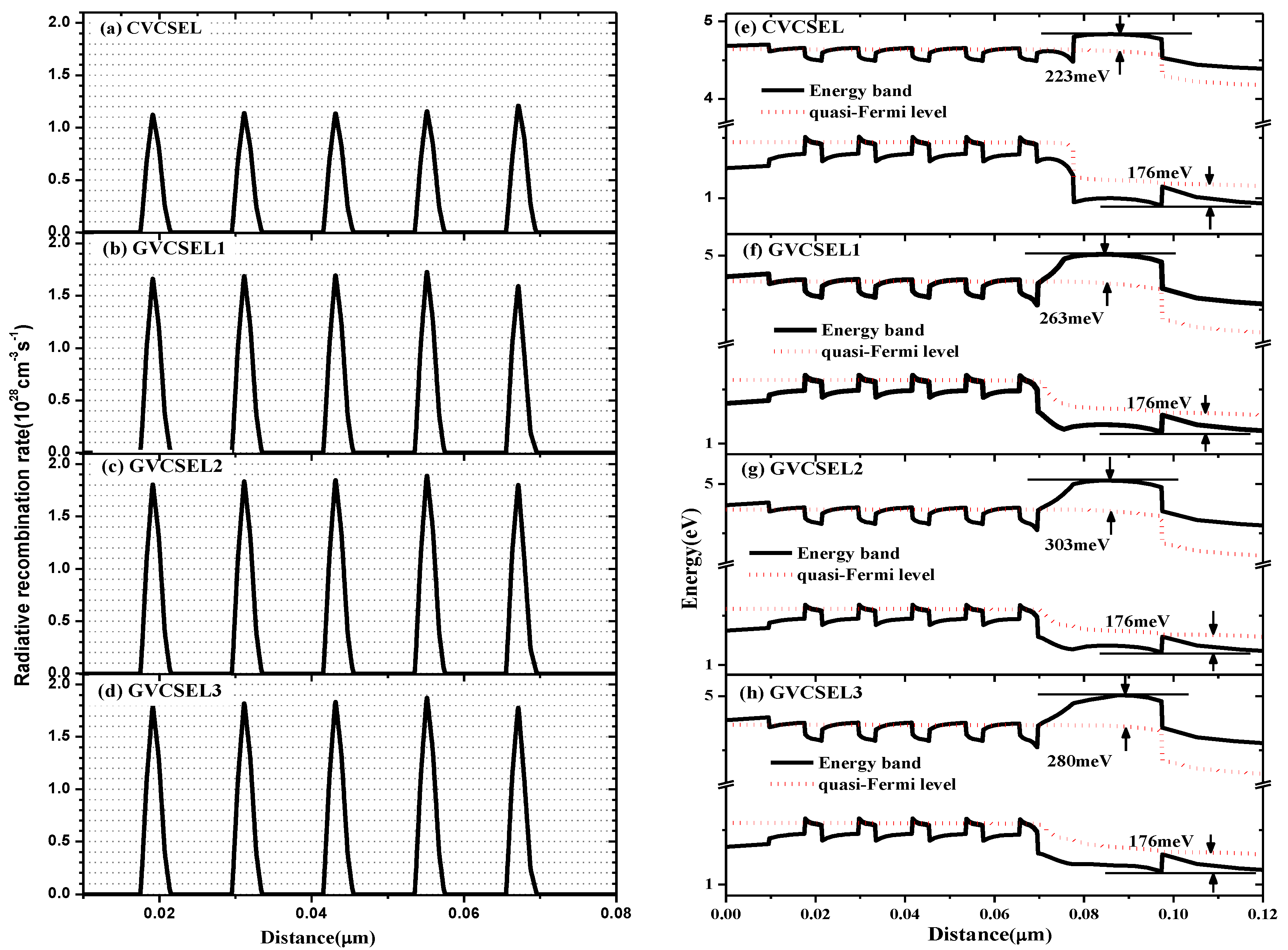Improved Output Power of GaN-based VCSEL with Band-Engineered Electron Blocking Layer
Abstract
:1. Introduction
2. Device Structure and Simulation Parameters
3. Results and Discussions
4. Conclusions
Author Contributions
Funding
Conflicts of Interest
References
- Hamaguchi, T.; Tanaka, M.; Mitomo, J.; Nakajima, H.; Ito, M.; Ohara, M.; Kobayashi, N.; Fujii, K.; Watanabe, H.; Satou, S. Lateral optical confinement of GaN-based VCSEL using an atomically smooth monolithic curved mirror. Sci. Rep.-UK 2018, 8, 10350. [Google Scholar] [CrossRef] [PubMed] [Green Version]
- Hamaguchi, T.; Nakajima, H.; Fuutagawa, N. GaN-based Vertical-cavity surface-emitting lasers incorporating dielectric distributed bragg reflectors. Appl. Sci. 2019, 9, 733. [Google Scholar] [CrossRef]
- Forman, C.A.; Lee, S.; Young, E.C.; Kearns, J.A.; Cohen, D.A.; Leonard, J.T.; Margalith, T.; DenBaars, S.P.; Nakamura, S. Continuous-wave operation of m-plane GaN-based vertical-cavity surface-emitting lasers with a tunnel junction intracavity contact. Appl. Phys. Lett. 2018, 112, 111106. [Google Scholar] [CrossRef]
- Takeuchi, T.; Kamiyama, S.; Iwaya, M.; Akasaki, I. GaN-based vertical-cavity surface-emitting lasers with AlInN/GaN distributed Bragg reflectors. Rep. Prog. Phys. 2018, 82, 012502. [Google Scholar] [CrossRef]
- Carlin, J.F.; Zellweger, C.; Dorsaz, J.; Nicolay, S.; Christmann, G.; Feltin, E.; Butté, R.; Grandjean, N. Progresses in III-nitride distributed Bragg reflectors and microcavities using AlInN/GaN materials. Phys. Status Solidi B 2005, 242, 2326–2344. [Google Scholar] [CrossRef]
- Lai, Y.-Y.; Chang, T.-C.; Li, Y.-C.; Lu, T.-C.; Wang, S.-C. Electrically pumped III-N microcavity light emitters incorporating an oxide confinement aperture. Nanoscale Res. Lett. 2017, 12, 15. [Google Scholar] [CrossRef]
- Higuchi, Y.; Omae, K.; Matsumura, H.; Mukai, T. Room-temperature CW lasing of a GaN-based vertical-cavity surface-emitting laser by current injection. Appl. Phys. Express 2008, 1, 121102. [Google Scholar] [CrossRef]
- Forman, C.A.; Lee, S.; Young, E.C.; Kearns, J.A.; Cohen, D.A.; Leonard, J.T.; Margalith, T.; DenBaars, S.P.; Nakamura, S. Continuous-wave operation of nonpolar GaN-based vertical-cavity surface-emitting lasers. In Proceedings of the Gallium Nitride Materials and Devices XIII, International Society for Optics and Photonics, San Francisco, CA, USA, 23 February 2018; p. 105321C. [Google Scholar]
- Wu, J.-Z.; Long, H.; Shi, X.-L.; Ying, L.-Y.; Zheng, Z.-W.; Zhang, B.-P. Reduction of lasing threshold of gan-based vertical-cavity surface-emitting lasers by using short cavity lengths. IEEE Trans. Electron Dev. 2018, 65, 2504–2508. [Google Scholar] [CrossRef]
- Hayashi, N.; Ogimoto, J.; Matsui, K.; Furuta, T.; Akagi, T.; Iwayama, S.; Takeuchi, T.; Kamiyama, S.; Iwaya, M.; Akasaki, I. A GaN-Based VCSEL with a convex structure for optical guiding. Phys. Status Solidi A 2018, 215, 1700648. [Google Scholar] [CrossRef]
- Kuramoto, M.; Kobayashi, S.; Akagi, T.; Tazawa, K.; Tanaka, K.; Saito, T.; Takeuchi, T. Improvement of slope efficiency and output power in GaN-based VCSELs with SiO2-buried lateral index guide. In Proceedings of the 2018 IEEE International Semiconductor Laser Conference, Santa Fe, NM, USA, 16–19 September 2018; pp. 1–2. [Google Scholar]
- Chusseau, L.; Philippe, F.; Viktorovitch, P.; Letartre, X. Mode competition in a dual-mode quantum-dot semiconductor microlaser. Phys. Rev. A 2013, 88, 015803. [Google Scholar] [CrossRef]
- Canet-Ferrer, J.; Martínez, L.J.; Prieto, I.; Alén, B.; Muñoz-Matutano, G.; Fuster, D.; González, Y.; Dotor, M.L.; González, L.; Postigo, P.A. Purcell effect in photonic crystal microcavities embedding InAs/InP quantum wires. Opt. Express. 2012, 20, 7901–7914. [Google Scholar] [CrossRef] [PubMed] [Green Version]
- Baba, T.; Sano, D. Low-threshold lasing and Purcell effect in microdisk lasers at room temperature. IEEE J. Quantum Elect. 2003, 9, 1340–1346. [Google Scholar] [CrossRef]
- Haglund, Å.; Hashemi, E.; Bengtsson, J.; Gustavsson, J.; Stattin, M.; Calciati, M.; Goano, M. Progress and challenges in electrically pumped GaN-based VCSELs. In Proceedings of the Semiconductor Lasers and Laser Dynamics VII, International Society for Optics and Photonics Europe, Brussels, Belgium, 28 April 2016; p. 908920Y. [Google Scholar]
- Piprek, J.; Farrell, R.; DenBaars, S.; Nakamura, S. Effects of built-in polarization on InGaN-GaN vertical-cavity surface-emitting lasers. IEEE Photonics Technol. Lett. 2005, 18, 7–9. [Google Scholar] [CrossRef] [Green Version]
- Cheng, L.; Cao, C.; Ma, J.; Xu, Z.; Lan, T.; Yang, J.; Chen, H.; Yu, H.; Wu, S.; Yao, S. Suppressed polarization effect and enhanced carrier confinement in InGaN light-emitting diodes with GaN/InGaN/GaN triangular barriers. J. Appl. Phys. 2018, 123, 223104. [Google Scholar] [CrossRef]
- Li, Z.; Lestrade, M.; Xiao, Y.; Li, Z.S. Improvement of performance in p-side down InGaN/GaN light-emitting diodes with graded electron blocking layer. Jpn. J. Appl. Phys. 2011, 50, 080212. [Google Scholar] [CrossRef]
- Zhang, Y.; Kao, T.-T.; Liu, J.; Lochner, Z.; Kim, S.-S.; Ryou, J.-H.; Dupuis, R.D.; Shen, S.-C. Effects of a step-graded AlxGa1−xN electron blocking layer in InGaN-based laser diodes. J. Appl. Phys. 2011, 109, 083115. [Google Scholar] [CrossRef]
- Lin, B.C.; Chang, Y.A.; Chen, K.J.; Chiu, C.H.; Li, Z.Y.; Lan, Y.P.; Lin, C.C.; Lee, P.T.; Kuo, Y.K.; Shih, M.H. Design and fabrication of a InGaN vertical-cavity surface-emitting laser with a composition-graded electron-blocking layer. Laser Phys. Lett. 2014, 11, 085002. [Google Scholar] [CrossRef]
- Piprek, J.; Li, Z.-M.; Farrell, R.; DenBaars, S.P.; Nakamura, S. Electronic properties of InGaN/GaN vertical-cavity lasers. In Nitride Semiconductor Devices: Principles; Piprek, J., Ed.; Wiley-VCH: New York, NY, USA, 2007; pp. 423–445. [Google Scholar]
- Xia, C.S.; Li, Z.S.; Lu, W.; Zhang, Z.H.; Sheng, Y.; Hu, W.D.; Cheng, L.W. Efficiency enhancement of blue InGaN/GaN light-emitting diodes with an AlGaN-GaN-AlGaN electron blocking layer. J. Appl. Phys. 2012, 111, 094503. [Google Scholar] [CrossRef]
- Fiorentini, V.; Bernardini, F.; Ambacher, O. Evidence for nonlinear macroscopic polarization in III–V nitride alloy heterostructures. Appl. Phys. Lett. 2002, 80, 1204–1206. [Google Scholar] [CrossRef]
- Wang, C.; Ke, C.; Lee, C.; Chang, S.; Chang, W.; Li, J.; Li, Z.; Yang, H.; Kuo, H.; Lu, T. Hole injection and efficiency droop improvement in InGaN/GaN light-emitting diodes by band-engineered electron blocking layer. Appl. Phys. Lett. 2010, 97, 261103. [Google Scholar] [CrossRef] [Green Version]
- Vurgaftman, I.; Meyer, J.R.; Ram-Mohan, L.R. Band parameters for III-V compound semiconductors and their alloys. J. Appl. Phys. 2001, 89, 5815–5875. [Google Scholar] [CrossRef]
- Turin, V.O. A modified transferred-electron high-field mobility model for GaN devices simulation. Solid State Electron. 2005, 49, 1678–1682. [Google Scholar] [CrossRef]




| Sample Name | GVCSEL1 | GVCSEL2 | GVCSEL3 |
|---|---|---|---|
| p-Al0.21Ga0.79N | 22 nm | 20 nm | 10 nm |
| p-Al0→0.21Ga1→0.79N | 6 nm | 8 nm | 16 nm |
© 2019 by the authors. Licensee MDPI, Basel, Switzerland. This article is an open access article distributed under the terms and conditions of the Creative Commons Attribution (CC BY) license (http://creativecommons.org/licenses/by/4.0/).
Share and Cite
Luo, H.; Li, J.; Li, M. Improved Output Power of GaN-based VCSEL with Band-Engineered Electron Blocking Layer. Micromachines 2019, 10, 694. https://doi.org/10.3390/mi10100694
Luo H, Li J, Li M. Improved Output Power of GaN-based VCSEL with Band-Engineered Electron Blocking Layer. Micromachines. 2019; 10(10):694. https://doi.org/10.3390/mi10100694
Chicago/Turabian StyleLuo, Huiwen, Junze Li, and Mo Li. 2019. "Improved Output Power of GaN-based VCSEL with Band-Engineered Electron Blocking Layer" Micromachines 10, no. 10: 694. https://doi.org/10.3390/mi10100694
APA StyleLuo, H., Li, J., & Li, M. (2019). Improved Output Power of GaN-based VCSEL with Band-Engineered Electron Blocking Layer. Micromachines, 10(10), 694. https://doi.org/10.3390/mi10100694




